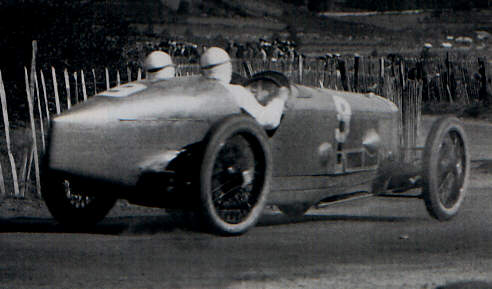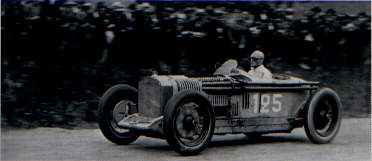Delage 2LCV

Robert Benoist in the French GP, Lyon, 1924.
Louis Delage instructed his cousin and chief engineer Charles Planchon to build the 2LCV model in
late 1922, and in three months later the first version of this V12 engined car was built. The cylinders
were at an angle of 60 degrees, with a capacity of 1992cc. The exhausts were in the centre of the vee.
A Zenith carburettor was used for each block of cylinders, and was mounted on the outside of the engine.
Two valves per cylinder at an included angle of 100 degrees were used, with the pistons cast from
aluminium alloy. The cylinder blocks were cast-iron, with a light-alloy crankcase. There werer four
overhead camshafts. Due to the smooth torque, there was no flywheel - a clutch disc was used for the
multi-plate clutch. Power output was about 116 bhp at 5400 rpm, through a four-speed gearbox. Wheelbase
was 8ft6in (2m59cm) on a channel-section chassis.
The car was entered in the French GP at Tours in July 1923, even though Planchon thought the car
underdeveloped - it subsequently retired with a broken crankshaft. Planchon was then sacked, being
replaced by Lory for 1924, who developed a disc-shaped bearing for mounting the engine at the front,
relieving the engine from torsional stress. The compression ratio was increased to 7:1 with
twin-choke Zenith carburettors, increasing power to 120 bhp at 6000 rpm. The chassis was modified,
and the bodywork modified. For 1925, two seater bodywork remained compulsory, but a riding mechanic
need not be carried, and Delage added two large Roots-type blowers. Some say that the capacity was
reduced by reducing the bore, resulting in 1973cc. Power was now 195 bhp at 6500 rpm. This modified car
can be seen below.

Benoist at the Gaillon Hillclimb, 1925.
The car was still largely unsuccessful, although it won the 1925 San Sebastian GP (Torchy was killed
driving a 2LCV in the race). For 1926, a simplier straight 8 1500cc voiturette was developed, and the
2LCV raced no further in European Grand Prix. However, M Becquet used one to develop his 12 litre
Hispano-Suiza engined special, and a Mr Malcolm drove one to win the 1927 Argentine 500 Miles at
Rafaela - this particular car was racing as late as 1942.
|